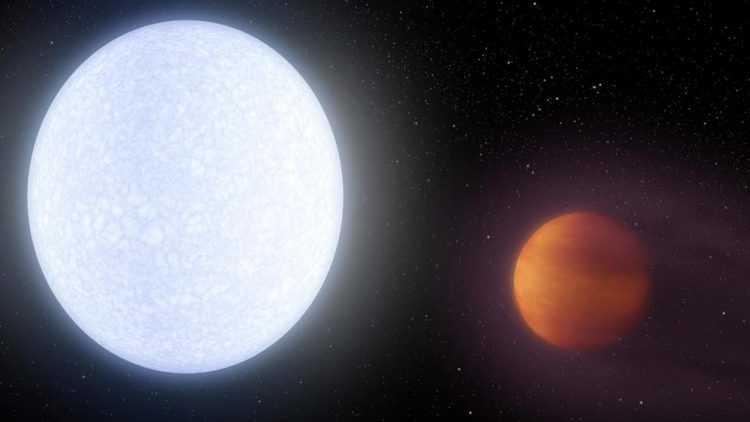New Jupiter-like world so hot it stretches definition of 'planet'

This is an artist's rendering of KELT-9b and KELT-9. KELT-9b is a gas giant 2.8 times more massive than Jupiter but only half as dense. KELT-9b orbits a star, KELT-9, which is more than twice as large and nearly twice as hot as our sun. Credit: NASA/JPL-Caltech/R. Hurt (IPAC)
A newly discovered Jupiter-like world is so hot that it's stretching the definition of the word “planet.”
With a day-side temperature of 4,600 Kelvin (more than 7,800 degrees Fahrenheit), planet KELT-9b is hotter than most stars, and only 1,200 Kelvin (about 2,000 degrees Fahrenheit) cooler than our own sun.
In an article in this week's issue of Nature, an international research team led by astronomers at Ohio State University and Vanderbilt University describes a planet with some very unusual features. The article is titled “A giant planet undergoing extreme ultraviolet irradiation by its hot massive-star host.”
Two Lehigh University astronomers — Joshua Pepper , assistant professor of physics, and doctoral candidate Jonathan Labadie-Bartz–coauthored the study, which was also presented at the spring meeting of the American Astronomical Society.
KELT-9b is a gas giant 2.8 times more massive than Jupiter but only half as dense, because extreme radiation from its host star has caused its atmosphere to puff up like a balloon. And because it is tidally locked to its star — as the moon is to Earth — the day side of the planet is perpetually bombarded by stellar radiation, and as a result is so hot that molecules such as water, carbon dioxide and methane can't form there. The properties of the night side are still mysterious — molecules may be able to form there, but probably only temporarily.
“It's a planet by any of the typical definitions based on mass, but its atmosphere is almost certainly unlike any other planet we've ever seen just because of the temperature of its day side,” said Scott Gaudi, professor of astronomy at Ohio State University and a leader of the study.
KELT-9b orbits a star, dubbed KELT-9, which is more than twice as large and nearly twice as hot as our sun.
“KELT-9 radiates so much ultraviolet radiation that it may completely evaporate the planet,” said Keivan Stassun, a professor of physics and astronomy at Vanderbilt who directed the study with Gaudi. “Or, if gas giant planets like KELT-9b possess solid rocky cores as some theories suggest, the planet may be boiled down to a barren rock, like Mercury.”
That is, if the star doesn't grow to engulf it first. “KELT-9 will swell to become a red giant star in about a billion years,” said Stassun. “The long-term prospects for life, or real estate for that matter, on KELT-9b are not looking good.”
A possible UV-fueled tail
Given that its atmosphere is constantly blasted with high levels of ultraviolet radiation, the planet may even be shedding a tail of evaporated planetary material like a comet, Gaudi added.
While Gaudi and Stassun spend a lot of time developing missions designed to find habitable planets in other solar systems, the scientists said there's a good reason to study worlds that are unlivable in the extreme.
“As has been highlighted by the recent discoveries from the MEarth collaboration, the planet around Proxima Centauri, and the astonishing system discovered around TRAPPIST-1, the astronomical community is clearly focused on finding Earthlike planets around small, cooler stars like our sun,” said Gaudi. “They are easy targets and there's a lot that can be learned about potentially habitable planets orbiting very low-mass stars in general.
“On the other hand, because KELT-9b's host star is bigger and hotter than the sun, it complements those efforts and provides a kind of touchstone for understanding how planetary systems form around hot, massive stars,” Gaudi said.
Stassun added, “As we seek to develop a complete picture of the variety of other worlds out there, it's important to know not only how planets form and evolve, but also when and under what conditions they are destroyed.”
A tiny dip in stellar brightness
How was the new planet found?
In 2014, astronomers using the KELT-North telescope at Winer Observatory in Arizona noticed a tiny drop in the star's brightness–about half of one percent– that indicated that a planet may have passed in front of the star. The brightness dipped once every 1.5 days, which means the planet completes a “yearly” circuit around its star every 1.5 days.
Subsequent observations confirmed the signal to be due to a planet, and revealed it to be what astronomers call a “hot Jupiter”–the ideal kind of planet for the KELT telescopes to spot.
KELT is short for “Kilodegree Extremely Little Telescope.” Astronomers at Ohio State, Vanderbilt and Lehigh University jointly operate two KELTs (one each in the Northern and Southern Hemispheres) in order to fill a large gap in the available technologies for finding extrasolar planets.
Other telescopes are designed to look at very faint stars in much small sections of the sky, and at very high resolution. The KELTs, in contrast, look at millions of very bright stars at once, over broad sections of sky, and at low resolution.
It's a low-cost means of planet hunting, using mostly off-the-shelf technology: while a traditional astronomical telescope costs millions of dollars to build, the hardware for a KELT telescope runs less than $75,000.
“This discovery is a testament to the discovery power of small telescopes, and the ability of citizen scientists to directly contribute to cutting-edge scientific research,” said Pepper, who built the two KELT telescopes.
The astronomers hope to take a closer look at KELT-9b with other telescopes–including Spitzer, the Hubble Space Telescope (HST), and eventually the James Webb Space Telescope. Observations with HST would enable them to see if the planet really does have a cometary tail, and to determine how much longer that planet will survive its current hellish condition.
###
Besides Vanderbilt, Ohio State and Lehigh, American partner institutions include Fisk University, Pennsylvania State University, the Harvard-Smithsonian Center for Astrophysics, Las Cumbres Observatory Global Telescope Network, University of Notre Dame, NASA Ames Research Center, Bay Area Environmental Research Institute, Swarthmore College, IPAC, Brigham Young University, University of California-Santa Cruz, University of Wyoming, Louisiana State University, University of Louisville, Spot Observatory in Nashville, Westminster College, Kutztown University, University of Hawaii, University of Washington, Texas A&M University, Wellesley College, and the Winer Observatory in Sonoita, Arizona. International team members are from Denmark, Italy, Japan, Portugal, Switzerland, Australia, Germany and South Africa.
The study was largely funded by the National Science Foundation through an NSF CAREER Grant, NSF PAARE Grant and an NSF Graduate Research Fellowship. Additional support came from NASA via the Jet Propulsion Laboratory and the Exoplanet Exploration Program; the Harvard Future Faculty Leaders Postdoctoral Fellowship; Theodore Dunham, Jr., Grant from the Fund for Astronomical Research; and the Japan Society for the Promotion of Science.
Media Contact
All latest news from the category: Physics and Astronomy
This area deals with the fundamental laws and building blocks of nature and how they interact, the properties and the behavior of matter, and research into space and time and their structures.
innovations-report provides in-depth reports and articles on subjects such as astrophysics, laser technologies, nuclear, quantum, particle and solid-state physics, nanotechnologies, planetary research and findings (Mars, Venus) and developments related to the Hubble Telescope.
Newest articles

A universal framework for spatial biology
SpatialData is a freely accessible tool to unify and integrate data from different omics technologies accounting for spatial information, which can provide holistic insights into health and disease. Biological processes…

How complex biological processes arise
A $20 million grant from the U.S. National Science Foundation (NSF) will support the establishment and operation of the National Synthesis Center for Emergence in the Molecular and Cellular Sciences (NCEMS) at…

Airborne single-photon lidar system achieves high-resolution 3D imaging
Compact, low-power system opens doors for photon-efficient drone and satellite-based environmental monitoring and mapping. Researchers have developed a compact and lightweight single-photon airborne lidar system that can acquire high-resolution 3D…





















